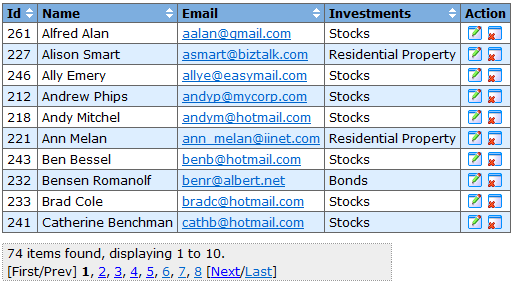The Table control also provides support for:
automatic rendering
column formatting and custom rendering
automatic pagination
link control support
A more advanced Table example is provided below:
public class CustomerPage extends Page { @Bindable protected Table table = new Table(); @Bindable protected PageLink editLink = new PageLink("Edit", EditCustomer.class); @Bindable protected ActionLink deleteLink = new ActionLink("Delete", this, "onDeleteClick"); // ------------------------------------- Constructor public CustomersPage() { // Setting Page to stateful to preserve Table sort and paging state while // editing customers setStateful(true);table.setClass(Table.CLASS_ITS); table.setPageSize(10); table.setShowBanner(true); table.setSortable(true); table.addColumn(new Column("id")); table.addColumn(new Column("name")); Column column = new Column("email"); column.setAutolink(true); column.setTitleProperty("name"); table.addColumn(column); table.addColumn(new Column("investments")); editLink.setImageSrc("/images/table-edit.png"); editLink.setTitle("Edit customer details"); editLink.setParameter("referrer", "/introduction/advanced-table.htm"); deleteLink.setImageSrc("/images/table-delete.png"); deleteLink.setTitle("Delete customer record"); deleteLink.setAttribute("onclick", "return window.confirm('Are you sure you want to delete this record?');"); column = new Column("Action"); column.setTextAlign("center"); AbstractLink[] links = new AbstractLink[] { editLink, deleteLink }; column.setDecorator(new LinkDecorator(table, links, "id")); column.setSortable(false); table.addColumn(column); } // ---------------------------------- Event Handlers /** * Handle the delete row click event. */ public boolean onDeleteClick() { Integer id = deleteLink.getValueInteger(); getCustomerService().deleteCustomer(id); return true; } /** * @see Page#onRender() */ @Override public void onRender() { List list = getCustomerService().getCustomersByName(); table.setRowList(list); } }
 | Setting Page to stateful instructs Click to store the Page in the HttpSession. This ensures the Table's sort and paging state is preserved while editing customers. See the Stateful Page section for more details. |
In this Page code example a Table control is declared and a number of
Column
objects are added. An editLink
PageLink
control is used as decorator for the "Action" column. This control navigates
to the EditCustomer page. A deleteLink
ActionLink
control is also used as a decorator for the "Action" column. This control will
invoke the Page onDeleteClick() method when it is
clicked. Finally we have the Page onRender() method
which is used to populate the Table control with rows before it is rendered.
In our Page template we simply reference the $table
object which is rendered when its toString() method
is called.
<html> <head>$headElements</head> <body>$table$jsElements</body> </html>
At runtime the Table would be rendered in the page as:
In this example, clicking on the Edit link will navigate the user to
the EditCustomer page where the selected customer
can be edited. When the user click on the Delete link, the
onDeleteClick() method will be called on the Page
deleting the customer record.
